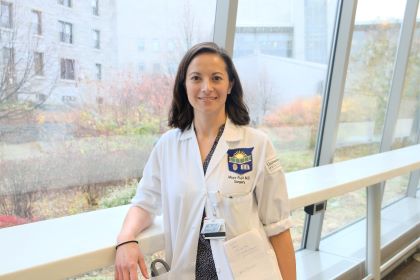November 8, 2019 by
American College of Surgeons
A study that evaluated opioid prescribing patterns at the University of Vermont Medical Center (UVMMC) before and after state-mandated regulations went into effect was presented by UVM Larner College of Medicine Clinical Instructor of Surgery Mayo Fujii, M.D., M.S., at the American College of Surgeons Clinical Congress 2019.

Mayo Fujii, M.D., M.S. (Photo: UVM Medical Communications)
A study that evaluated opioid prescribing patterns at the University of Vermont Medical Center (UVMMC) before and after state-mandated regulations went into effect found a drastic reduction in the quantity of opioids prescribed and used, but no signs of inadequate postoperative pain management in surgical patients. Clinical Instructor of Surgery Mayo Fujii, M.D., M.S., presented these findings at the American College of Surgeons Clinical Congress 2019, held in San Francisco, Calif., October 27 to 31.
Fujii is a 2013 graduate of the Larner College of Medicine at the University of Vermont and a chief resident in the Department of Surgery.
In July 2017, the Vermont Department of Health issued new rules for prescribing opioids for pain. These regulations require physicians to discuss with patients the risks and benefits of opioid analgesia, to counsel them on non-opioid analgesia as first-line treatment, and to educate them on the safe disposal of unused opioids. Patients sign an informed consent and providers are required to check a patient’s pain medication history in the state prescribing database (Vermont Prescription Monitoring System) before receiving a new prescription for opioids greater than 10 pills.
The study looked at opioid prescribing patterns at UVMMC for 15 common operations across four surgical specialties for 12 months before the regulations went into effect (n=365) and for 17 months afterward (n=768). This study found that the median morphine milligram equivalents (MME)—a measure of cumulative potency of pain meds prescribed—declined by 33 percent.
“The clear trend is that physicians are prescribing less, patients are using less, and there is no appreciable change in patient-reported pain control or satisfaction after implementation of these regulations,” said Fujii. “That patients are using less may reflect the impact of patient education efforts to establish expectations of postoperative pain and use non-opioid pain management strategies, as well as public awareness of the opioid epidemic.”
The study evaluated 15 different procedures ranging from less invasive to more invasive, in vascular, general, orthopedic and urologic surgery. The median MME prescribed before and after July 2017 were 96 and 64, respectively. Strikingly, the median MME used after surgery was zero (Range: 0 to 40 MMEs) after the regulations versus 16 MME (Range: 0 to 80 MMEs) before the regulations. The proportion of patients who did not receive any opioids after surgery more than doubled, from 12.7 percent to 26 percent after the regulations (p<0.05).
One possible concern about such a reduction in opioid prescribing after surgery, and for regulations limiting prescribing, is inadequate postoperative pain management, but study findings did not bear that out, Fujii said. “Despite the decrease in amount of medication prescribed, there did not appear to be any significant change in refill rates or patient-reported satisfaction with pain control,” she said. Prescription refill rates before and after the rule change were 5.5 percent and 6.3 percent, respectively, and similarly, the proportion of patients reporting an inadequate amount of medication were 11.0 percent and 12.3 percent before and after. Neither differences were statistically significant.
“Many of the components of these regulations have been reflected in other state-mandated policies. Patient education, particularly encouraging non-opioid pain management strategies was something that clearly increased after these regulations went into effect,” she said. “It’s an intervention that’s easily implemented and may contribute to patients using less opioid medication than they otherwise would have.” Patient education on non-opioid analgesia increased from 82 percent to 98 percent (p<0.001) during the study period as did instructions on opioid disposal (19 percent to 52 percent, p<0.001). “Although we observed an increase in patients receiving instructions on how to dispose of their medications, it was still around 52 percent,” Fujii said. “That’s significant progress compared with the 18 percent of patients who reported receiving disposal instructions before the regulations were implemented, but it still highlights room for improvement”, she said.
In addition to Fujii, the study authors include Ajai Malhotra, M.D.; Ethan Jones, M.P.H; Thomas Ahern, Ph.D., M.P.H.; Loic Fabricant, M.D.; and Christos Colovos, M.D., Ph.D.
(This article was adapted from a press release produced by the American College of Surgeons.)